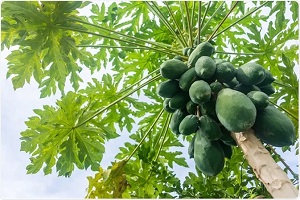How Much Does Papaya Cost?
The papaya was first cultivated in Mexico and is native to the tropical areas of the Americas. It is a fruit that comes from the Carica papaya. As for the US, currently, it only grows in the Hawaii area. The tree can bear fruits within three years, which means it grows rather rapidly. Papayas are considered very versatile fruits, as they are used for medicine, as cooking aids, and even as standalone food. You can eat it raw, as long as you remove its seeds.
How much does a papaya cost?
Fresh papayas usually cost between $2.5 to $12 per piece, or about $1 to $3 per pound, depending on factors like the grocery store that sells it, its size, and whether it is in season or not. The geographical proximity is another factor that will influence the pricing to quite a large extent, as the fruit is known to have a very short shelf life. The average papaya can reach a weight of up to 10 pounds, depending on the exact type you’re purchasing.
You will spend closer to $5 – $10 per pound for dried papaya, depending on where you purchase it from and the brand selling it.
You can also buy papaya seeds if you’re interested in planting them. Expect to spend between $1 and $5 per pack, as these seeds are usually sold in packs of 10.
Fresh papaya costs about $1.30 per pound according to economic research done by The United States Department of Agriculture, while dried papaya will cost around $5.51 per pound.
Papaya powder can also be bought from big stores like Amazon to be used as a micro ingredient in foods. This powder will usually cost around $25 per pack.
Walmart sells fresh papaya, at the moment of this writing, for about $5.73 per fruit.
Papaya overview
A papaya is very similar in shape to a melon, being a thick-skinned tropical fruit. Not only its orange sugary sweet flesh is edible, but also the small black seeds you will find inside it. The skin is the only part that won’t be edible. Some people use green papayas for salads, pre-shredded or whole. These have a football shape. Green papayas are usually pale and firm.
Papaya comes in two main types:
- the Hawaiian type, that you will find in most grocery stores;
- the Mexican type, which is rarer and can reach as much as 10 pounds in weight.
Just one fruit is known for providing high amounts of folic acid, enzymes, amino acids, A vitamins, and B vitamins, and up to $144% of the daily recommended value of vitamin C.
It is usually in season between June and September.
You might also like our articles on the cost of oranges, spaghetti squash, or avocado.
A cup of this fruit usually holds about half a pound of fruit.
Some specialized Southeast Asian and Chinese grocery service stores are known to sell green papayas.
Further information on the fruit and its average market price
 When possible, it is a lot better to just eat a papaya fruit raw. The best flavor will come out of it when left uncooked, according to experts, although there are a lot of recipes that use them cooked. When eating it raw, make sure you remove all of the seeds. You then scoop out the flesh of the fruit with a spoon and just eat it. You can even dip it in yogurt if you want a healthy, simple snack with a lot more flavor.
When possible, it is a lot better to just eat a papaya fruit raw. The best flavor will come out of it when left uncooked, according to experts, although there are a lot of recipes that use them cooked. When eating it raw, make sure you remove all of the seeds. You then scoop out the flesh of the fruit with a spoon and just eat it. You can even dip it in yogurt if you want a healthy, simple snack with a lot more flavor.
Butter and cinnamon are known as great seasonings to complement the fruit.
The seeds of the papaya fruit are also used as an amazing substitute for pepper.
You can also use pureed papaya to tenderize meats. This puree can also be used as a sauce for pancakes or ice cream.
Ripe papayas don’t have black spots on the skin, have a yellow color for the skin, and will be soft to the touch. You can still slice an unripe papaya thinly and cook it as you would squash.
How can I save money?
The best papayas to purchase are the ones sold during the peak season, which is in the summer. This is also when you will get the best prices on these fruits.
Most of the time, chain grocery stores will have higher prices on papaya than Local farmer’s markets.

Leave a Reply
Want to join the discussion?Feel free to contribute!